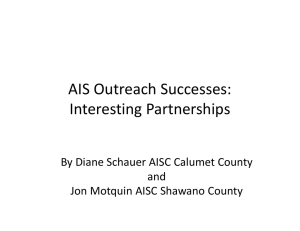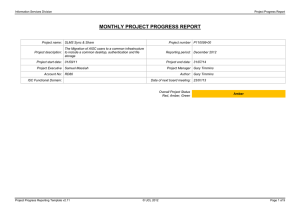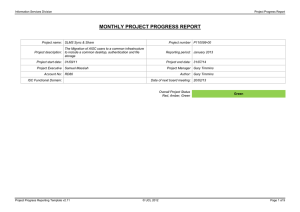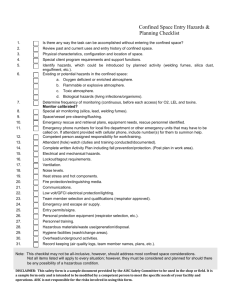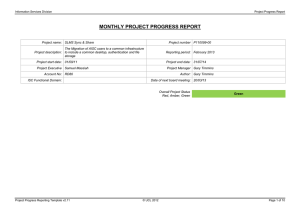Project Initiation Document (PID) AISC Systems Migration & Device Sync
advertisement
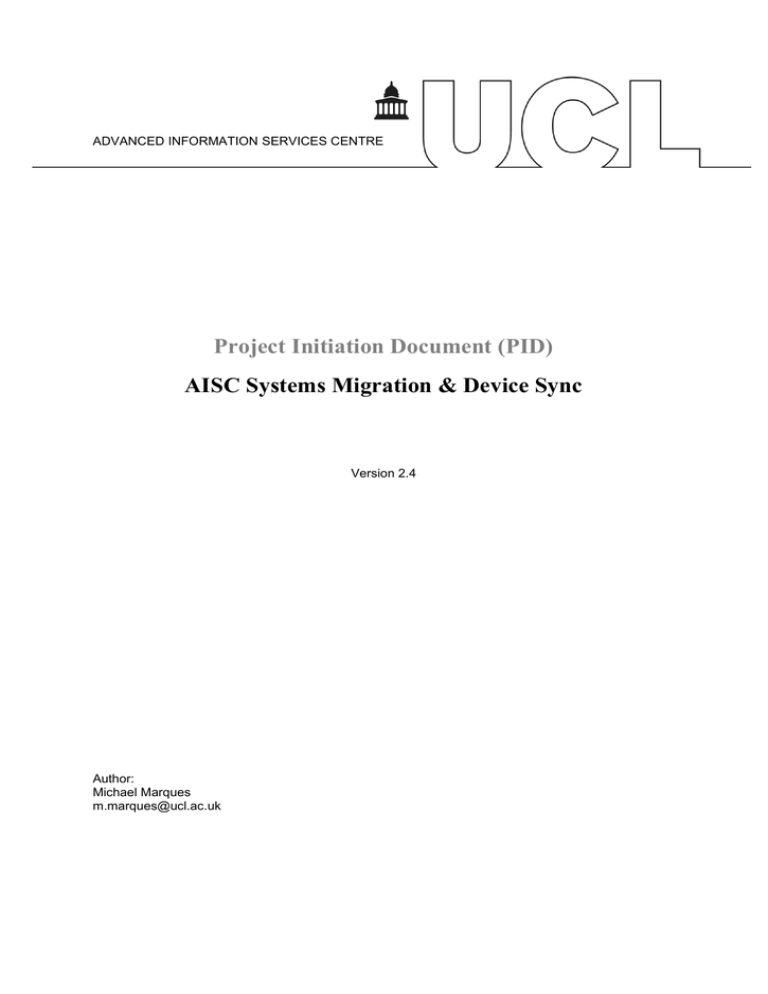
ADVANCED INFORMATION SERVICES CENTRE Project Initiation Document (PID) AISC Systems Migration & Device Sync Version 2.4 Author: Michael Marques m.marques@ucl.ac.uk AISC Systems Migration & Device Sync DOCUMENT HISTORY Document Completion st 1 Draft st 1 Review Version Author: Date Draft 0.1 Draft 0.2 12/9/11 23/09/11 Quality Assurance Board Review Draft v0.6 2.4 Michael Marques N woods S Massiah N Woods i 13/10/11 19/10/11 AISC Systems Migration & Device Sync Contents 1. 2 3 4. Business case 1.1 Background 3 3 1.2 Justification 3 1.3 Objectives 3 1.4 Benefits 4 1.5 Scope 4 1.6 Budget 5 1.7 Infrastructure 5 PROJECT Approach 2.1 Staff Resources 6 7 2.3 8 AISC Systems Migration Project Roll-Out Schedule Risk and Issues Quality Strategy 4.1 Responsibilities 9 10 10 4.2 Configuration Management 10 4.3 Acceptance Testing/Outcome 10 4.4 Project Quality 10 4.5 Change Control 10 5. Project Governance 5.1 Responsibilities 11 11 6. Project Plan 6.1 Milestones 13 13 6.3 Activity 14 6.4 Reporting Arrangements 14 6.5 Exception Management 14 6.6 Filing Arrangements 14 6.7 Assumptions 14 7. Communication Plan 7.1 General communication 7.2 15 15 Stakeholder communication 15 8. Training Plan Appendix A: Job Descriptions Appendix B: Change Request Form Appendix C: Activities GANTT chart Appendix D: Project Status Report 16 17 21 22 23 ii AISC Systems Migration & Device Sync 1. BUSINESS CASE The following sections set-out the business justification for the project and the parameters of what is to be delivered. 1.1 BACKGROUND Following the Biomedical Administration Review 2007 (BAR), the strategic vision was set to standardize IT services in the Faculty of Biomedical Sciences (FBS) and remove duplication. This would then free-up existing resources to be redeployed for specialist IT support for research, teaching & learning. The AISC IT Transformation Programme was established in 2010 to deliver that standardisation by first building faculty-wide technical solutions where necessary, and then managing the migration of thousands of Faculty users onto them. In 2010/11 the FBS Virtual Servers Project and FBS Active Directory Project, within the Transformation Programme, successfully designed, procured and built a state-of-the-art virtual server environment and single active directory. This introduced the technical capability to centrally host data and services, currently held on hundreds of separate physical servers located across the divisions, institutes and departments, and enable the secure authentication of users when accessing the data and services. 1.2 JUSTIFICATION The divisions, institutes and departments, which AISC support currently have multiple methods of authentication, data storage and services, with varying levels of technical sophistication, reliability and resilience. A requirement was identified by FBS Senior Staff to provide a faculty-wide data storage solution, which would provide a consistent level of service across the respective divisions and institutes, and provide greater security and resiliency. This would inherently reduce the risk of any inadequate safeguarding of research data and intellectual property, and provide a vastly enhanced service allowing collaboration and sharing of data across SLMS. There was also a requirement for a system to allow “home/personal” network stores to be seamlessly synchronised to laptop and desktop computers, to cater for users who travel widely and are often not network connected, and to improve the users’ ability to work during network or other service outages. Many users are already making use of commercially available technologies that achieve a multi device synchronous data store such as Dropbox, Box.net, Sugarsync, Mozy, ZumoDrive and SpiderOak. The Virtual Server environment and Active Directory are now available, and the thousands of AISC users and their data now need to be migrated to the new services, from their current physical servers. 1.3 OBJECTIVES The migration of all users across the Divisions, Institutes and Departments which AISC support, to the new Active Directory for authentication The migration of all users’ filestore requirements to the new enterprise file service, providing individual drives/stores and shared areas The migration of all users across the Divisions, Institutes and Departments which AISC support, to an standardised Windows 7 desktop, where appropriate Implementation of data synchronisation across multiple end point devices A quota of 50GB per individual user , with potential for more upon formal request A quota of 200GB per shared area, with unlimited user access, available upon request Extend the current service definition to include a data storage facility suitable for temporary raw research data. When this is defined the service definition should be revalidated with user’s representatives as a whole and submitted for board approval. Page 3 AISC Systems Migration & Device Sync 1.4 BENEFITS The specific benefits that the AISC Systems Migration & Device Sync Project enables are Improved data storage, quality and accessibility for all users. Improved data integrity, securing intellectual property and business continuity Improved remote access and collaboration, school-wide Enable more flexible working with the introduction of hot-desking Increased ease of moves between locations, as the solution is location independent Increased ability to use accommodation flexibly, as users data is no longer computerdependent Decreased user impact during system outages Reduction in AISC data maintenance costs across multiple systems & locations Ability to increase investment in specialist-IT services (research, teaching & learning) Consolidation and standardisation of support service levels Decrease use of email as a file store Readiness to integrate with the UCL Desktop solution, when it is delivered Readiness to integrate with the UCL Encryption solution, when it is delivered Readiness to integrate with the UCL DCHP solution, when it is delivered Reduction in Carbon footprint in line with UCL’s Green Policy 1.5 SCOPE The proposed deliverables of this project have been identified as: In Scope To migrate the existing 6500 users that came under FBS as required to the UCL Active Directory facility To migrate the existing 6500 users that came under FBS to the AISC data storage facility and make available the agreed data storage services To migrate existing and new computers that came under FBS to a standardised desktop, where appropriate (PC/Computer numbers are expected to exceed 6500 as many users have multiple devices. There are also many deployed to support meeting room and training requirements) To migrate existing and new computers that came under FBS to the UCL Active Directory facility (PC/Computer numbers are expected to exceed 6500 as many users have multiple devices. There are also many deployed to support meeting room and training requirements) To investigate, design and implement a device synchronization service On an exception basis, to also migrate application services hosted on physical servers to the virtual server environment, but only when the application must move with the users in order to be still accessed. Update any Service Definition Documentation for the Enterprise File Service to include synchronization of data for devices. Out of scope The decommissioning of redundant infrastructure (domain controllers & physical servers) will be tracked and monitored at the AISC IT Transformation Programme Board, in the Benefits Realisation Plan. This will allow this project to focus resources, and maintain pace, in achieving the successful migration of all users & computers to the new AISC Systems. The decommissioning of existing Windows Domain or Netware Directories these will be tracked and monitored at the AISC IT Transformation Programme Board, in the Benefits Realisation Plan. Encryption of data on the endpoint client device. Page 4 AISC Systems Migration & Device Sync 1.6 BUDGET The budget for this project is provided by a successful bid made to the Information Strategy Committee 1 (ISC) and is £345k in 2011/12 and £300k in 2012/13. 1.7 INFRASTRUCTURE The new infrastructure provides file system access to the Enterprise File System for AISC users with the ability to connect via Windows, Mac and Linux clients. Remote access is also provided to access the service securely from any location. 1 Bids 206 & 265 Page 5 AISC Systems Migration & Device Sync 2 PROJECT APPROACH The project will work to PRINCE2 and AISC IT Transformation Programme standards and guidelines. The project will form part of the overall AISC Transformation Programme, and will be managed in Stages, according to agreed project management standards. The stages are: Stage 0 – Project Start Up Stage 1 – Sync Service Design, Procurement and Implementation Stage 2a – Discovery & Planning – Users, Computers & Data (exceptional application services identified) Stage 2b - Migration – User, Computers & Data Local (& approved exceptional application services) Stage 2c – Stage Closure Final Stage – Project Closure Note: Stages 2a, 2b & 2c are repeated for each of the Institutes, Divisions and Departments that are supported by AISC, and can run concurrently. DISCOVERY & PLANNING The Discovery & Planning Stage will produce an inventory of users, their computers and their data hosting requirements. From the information gathered a work package for prerequisites will be complied and supplied to local IT Teams. When complete, the Migration Stage can begin. MIGRATION The migrations will be scripted and form a repeatable process to be followed by Desktop Migration Engineers, with exceptions escalated to Systems Engineers. In order to minimise the impact on users it is intended PC backup will be initiated at 5pm to run over night. User’s machines will then be replaced by a temporary PC whist their PC is reimaged and joined to AD. Any user specific software will then be deployed using Group Policy and when the engineer check list is complete the machine can be swapped back. At this point data migrations or copies can be in initiated after which user orientation and sign-off will be completed. Desktop Migration Engineers and Systems Engineers will be identifiable to the users by project polo shirts. Page 6 AISC Systems Migration & Device Sync ROLL-OUT SCHEDULE In principle, the project will follow the migration schedule of the AISC live@UCL Project, in order to benefit from: User account data cleansing already undertaken Physical desktop upgrades already undertaken Any local mail server dependencies already removed AISC live@ucl planning, which has already taken into account & accommodated the most inneed user groups first, and left those with the most resilient infrastructure (with current support contracts) until last. Migration to the new systems, whilst following AISC live@UCL migrations, should allow a 6 month gap so as to distribute any disruption to the users. As with the AISC live@UCL Project, there will be parallel work streams running concurrently, so whilst one area is performing prerequisite activity, another is undertaking discovery & planning, and another is migrating etc. 2.1 STAFF RESOURCES At this stage of the project the following staff resources requirements have been identified: (Dates and allocation to be confirmed with the project board at a later date) Role Total No Days Allocated to Project, per week From To Project Manager (M Marques) Senior Supplier Head of Client Services (A Harper) Senior Supplier Head of Infrastructure Services (R Passey) Central Cluster IT Teams* 5 05/9/11 31/7/12 2.0 05/9/11 31/7/12 2.0 05/9/11 31/7/12 2.0 Discovery & Planning 4.0 Migration 05/9/11 31/7/12 Northern Cluster IT Teams* 2.0 Discovery & Planning 4.0 Migration 05/9/11 31/7/12 Southern Cluster IT Teams* 2.0 Discovery & Planning 4.0 Migration 05/9/11 31/7/12 Migration Team Systems Engineers x 2 Desktop Migration Engineers x 3 IT Staff and User Support Training 01/11/11 31/7/12 5.0 5.0 0.5 05/9/11 31/7/12 Programme Manager 0.5 05/9/11 31/7/12 *At relevant times, according to the roll-out schedule Page 7 AISC Systems Migration & Device Sync 2.3 AISC SYSTEMS MIGRATION PROJECT ROLL-OUT SCHEDULE Division, Institute or Department AISC Migration Group 1 CHIME Dept. of Infection & Population Health (IPH) – Mortimer Market Centre Ear Institute Dept. of Epidemiology & Public Health (EPH) AISC Migration Group 2 All Users on the Medsch IT Domain (Royal Free, Whittington, Maple House) AISC Migration Group 3 Institute of Neurology Institute of Women’s Health Dept. of Research Strategy Division of Surgery (Stanmore) Division of Medicine AISC Migration Group 4 Institute of Cardiovascular Sciences Institute of Child Health Eastman Dental Institute Infection & Immunity Division of Surgery (Bloomsbury) DoME (Bloomsbury) AISC Migration Group 5 Primary Care & Population Health (PCPH) Institute of Ophthalmology Cancer Institute Wolfson Institute of Biomedical Research (WIBR) AISC Migration Group 6 Mop Up Group A Mop Up Group B Mop Up Group C Mop Up Group D Page 8 Live@UCL Infrastructure migration August 2010 February 2011 November 2011 November 2011 February 2011 April 2011 December 2011 January 2012 May & June 2011 Q1 2012 July 2011 August 2011 August 2011 August 2011 September 2011 Q2 2012 Q3 2012 Q3 2012 Q3 2012 Q3 2012 September 2011 October & November 2011 November 2011 December 2011 December 2011 December 2011 Q4 2012 Q4 2012 January 2012 February 2012 March 2012 March 2012 Q1 2013 Q1 2013 Q1 2013 Q1 2013 April 2012 May 2012 June 2012 July 2012 Q2 2013 Q2 2013 Q3 2013 Q3 2013 Q4 2012 Q4 2012 Q4 2012 Q4 2012 AISC Systems Migration & Device Sync 3 RISK AND ISSUES The following high-level risks & issues have been identified at this stage of the project. Further risk & issue management will be followed in the monthly project reports, and brought to the attention of the project steering group. Each migration group is likely to have its own identified and specific set of risks and issues, related to the detail of those particular migrations, initial risk & issues log can be found below; Ref Risk Description 1 Not being able to find one synchronisation tool for all client devices Area yet to be allocated where PC’s can be rebuilt. 3 3 Medium May need to implement more than one solution 3 3 Medium 3 Impact of the 2012 Olympics on roll-out schedules 5 4 High 4 Data security, data loss during migration to a new PC image 3 3 Medium 5 Data security, data sets currently containing a mixture of data types including patient identifiable data 5 5 High 6 Service disruption during migration 3 3 Medium A suitable area that can house 2 racks and have required network speed needs to be allocated. Adjust roll-out schedules accordingly for Bloomsbury area and focus on remote sites outside the affected area. End user education ensuring data is stored in agreed location. Backup of PC prior to migration. End user education and perquisite requirements to separate data types in advance on migration. A policy by which to manage data types including patient identifiable data is a deliverable of an AISC project which is currently in start-up. Ensure project plan is known and agreed to limit disruption 2 Probability Impact Severity Mitigation Note: An issue is defined as an outcome/event has already occurred. ID Issue Description Severity Mitigation 1 Delayed delivery of SmartIT phase 3 across AISC Moderate System Administrators will have to be recruited on a temp basis to cover on-going support. Page 9 AISC Systems Migration & Device Sync 4. QUALITY STRATEGY 4.1 RESPONSIBILITIES It is the project board’s responsibility to assure itself as to the quality of the project and the delivered products. Individual members may achieve this by delegating quality control to other staff not involved in this project. The project board should assure itself that all activities contained in the relevant stage of the project checklist are completed, or have a good reason for non-completion, before giving authority to proceed to the next stage. 4.2 CONFIGURATION MANAGEMENT The project manager will hold copies of all project documentation. Documentation will be held on ISD Wiki site. Authorised users will have electronic access to all project documentation and be allowed to dynamically share and collaborate on future documentation. 4.3 ACCEPTANCE TESTING/OUTCOME Acceptance testing will be carried out during each activity stage of the project by members of the project team. Results from these tests will be provided to the project board. Users at each of the Divisions or Institutes will be expected to test and sign-off all applications working from within AD prior to migration. This will require PC’s to be setup with the AISC build and all Div / Inst applications installed joined to AD and located in the user area from where the testing can be actioned. 4.4 PROJECT QUALITY An end-of-project review will be completed by the project board within 6 months of the end of the project. The project executive, with the project manager, will carry out reviews at the end of each project stage. Project documentation quality reviews will be completed by the project manager, prior to publication. 4.5 CHANGE CONTROL All Requests for Change (RFC’s) must be presented for approval by the project manager in a standard format. Note: A sample of the RFC form to be used can be found in Appendix B, page 2. Changes will only be acted upon on receipt of an approved Project Managers Instruction (PMI). When additional resource is required, or the proposed change(s) significantly affect deliverables, authorisation will be required from a member of the project board. Project plan milestone changes will also need to be submitted to change control. Page 10 AISC Systems Migration & Device Sync 5. PROJECT GOVERNANCE 5.1 RESPONSIBILITIES The following governance structure has been identified to provide management for the AISC systems Migration project. AISC Systems Migration & Device Sync Project Board Samuel Massiah: Chair – Project Executive Michael Marques: Project Manager Senior Users: SLMS Faculty Managers: Geoff Dunk – Brain Sciences Paul Phibbs – Population Health Sciences Edna Murphy – Medical Sciences Senior User: IT IoN Rick Davis Senior Suppliers: Alan Harper: AISC Head of Client Services (Desktop & Devices) Ric Passey: AISC Head of Infrastructure (Data & Services) Nicola Woods: Project Quality Assurance Zaman Wong: Project Support Project Steering Group Project Manager: Michael Marques Samuel Massiah: Project Executive Alan Harper: Senior Supplier Ric Passey: Senior Supplier Nicola Woods: Quality Assurance Project Working Group(s) Project Manager: Michael Marques Training Support: Kristina Drew Senior Suppliers: Alan Harper Ric Passey Relevant AISC Cluster Lead* Relevant AISC IT Lead* System Engineers x2 * Relevant to roll-out schedule Job description details are provided in Appendix A Page 11 AISC Systems Migration & Device Sync 5.2 MEETINGS ARRANGEMENTS Project Board meetings will be held monthly. In the absence of a project board meeting functions carried out by this team will be fulfilled by direct contact between the project manager and the appropriate parties on an ‘as needed’ basis. Page 12 AISC Systems Migration & Device Sync 6. PROJECT PLAN 6.1 MILESTONES Milestone Name Estimated Delivery Date Stage 0 – Project Start Up Project Brief Project Manager Appointment High-Level Discovery High- Level Planning Project Initiation Document Produced Project Initiation Document Approved Stage 0 complete Stage 1 – Technical Solution (Sync, DHCP & App delivery) Investigation Synchronisation Investigation DHCP Investigation Application Delivery Solution Proposal Approved Solution Procurement Stage 1 Complete Stage 2a – Discovery & Planning – Users, Computers & Data Audit and discovery Prerequisites UAT testing of all applications on from AD Domain Stage 2b – Migration – Users, Computers & Data AD, Desktop and Data migrations Stage 2c – Stage Closure Stage 2 complete Stages 2a, 2b &2c are repeated for each of the Institutes, Divisions & Departments that are supported by AISC. See Appendix C. It is envisaged that it will take two years to migrate all users and services to the AISC desktop, AD, Data hosting service and Virtual server hosting service. Final Stage – Project Closure Handover & Acceptance Project Closure Document Approved Final stage complete Page 13 Complete Complete Complete Complete 13/10/11 19/10/11 19/10/11 11/11/11 11/11/11 11/11/11 18/10/11 25/11/11 02/12/11 CHIME 28/10/11 04/11/11 11/11/11 CHIME 25/11/11 31/12/11 31/12/11 31/8/13 30/09/13 AISC Systems Migration & Device Sync 6.3 ACTIVITY Activities GANTT chart can be found in Appendix C. 6.4 REPORTING ARRANGEMENTS The project manager will report monthly, or more frequently, if required, to the project board and project executive. The project manager will use the report templates and process documented by the ISD PMO. 6.5 EXCEPTION MANAGEMENT Where circumstance variation(s) fundamentally change resource requirements, or agreed milestone time scale. Overrun(s) will be regarded as exception(s). An Issue Log will be maintained in the project SharePoint site and form part of the monthly project reporting. All exceptions to tolerances, quality failures, or other issues raised by project members will be recorded in the issue log. Any exception, or threatened exception, to tolerances will be highlighted in the project manager’s status report. As will any issue that cannot be resolved by the project manager. 6.6 FILING ARRANGEMENTS All project documents will be managed and maintained by the project manager within the transformation program shared area of the project SharePoint site. 6.7 ASSUMPTIONS Key project assumptions are: The required resource will be made available by the underlying support teams within AISC for operational support as part of phase III of SmartIT. Apply fixed IP’s or deploy interim departmental DHCP scopes to be migrated to the UCL DHCP platform when delivered Applications will be packaged in Adminstudio and deliver via Group Policy when required Page 14 AISC Systems Migration & Device Sync 7. COMMUNICATION PLAN 7.1 GENERAL COMMUNICATION Project Board – Structured monthly meeting to review the overall project supported by risks and issues log, project report, decisions required, actions to be taken etc. Pre meeting agenda will be sent along with post meeting minutes circulated with decisions and actions Monthly Reports – Forming part of the transformation program report details of the project will be published to a set format Project team meeting – Transformation PM’s will meet once a month to present updates on the respective projects Working group meetings – Weekly meetings will be held with representation from AISC, DCS & NS during the build stage Newsletters - Project progress will be reported to the wider AISC user base using a transformation program update on a monthly basis Share point site – Working group documentation will be published to a project share point site as and when required 7.2 STAKEHOLDER COMMUNICATION As has been the case with the AISC live@UCL Project the stakeholders for each of the Divisions or Institutes will be brought together prior to work beginning in their area and be presented with the project overview and how it will affect them for discovery through migration and closure. This will form part of the repeatable process as we pass though each of the Divisions and Institutes. 1 month before migration - Migration Group Senior Stakeholder Presentation - all division & institute managers 3-4 weeks before migration - VIP email comms 3-4 weeks before migrations start - All-user comms 2 weeks before migrations start - User Rep comms 1 week before personal migrations - Users 3 days before personal migrations – Users Start Guide Page 15 AISC Systems Migration & Device Sync 8. TRAINING PLAN Quick start end user service information, to be delivered via a ‘Flash movie’ hosted on the AISC web site. e.g. Explaining that all local data needs to be in the users profile or centrally stored on a server. Basic end user training will be required in the form of referral documentation regarding the data storage service. This would outline the process by which a storage request is made, permissions and backup cycle applied. AISC IT support teams will need training in order to support the data storage service and virtual server hosting service for purposes of initial contact. A skills gap analysis has taken place during the AISC virtual server project and the skills gaps were identified and a training plan was approved and is already in place. Page 16 AISC Systems Migration & Device Sync APPENDIX A: JOB DESCRIPTIONS Appendix A: Job Descriptions I Project board 17 II Project board executive role 18 III Project board senior supplier role 18 IV Project board senior user role 19 V Project manager 20 VI Project team 20 I Project Board Purpose: To agree the terms of reference of the project as identified in the PID To review and accept detailed project plans To agree responsibilities of key personnel connected with the project To appoint individuals to the Project Team To review exceptions and approve action them as they arise To ensure all ‘products’ are delivered To sign off stages off the project To review the project To be responsible for project quality To close off the project when all products have been delivered To be responsible for post-implementation review and benefits realisation study Reporting Arrangements: The AISC System Migration Project will make its reports available to the AISC Transformation Program Board. Composition: Executive role Senior supplier role Senior user role Attendance at Meetings: Project Manager Meetings: Initial (to accept PID) Monthly for reports on progress At end of project In the event of significant exceptions Note: The executive role is empowered to sign off products and authorise action on exceptions without calling a meeting. Page 17 AISC Systems Migration & Device Sync II Project Board Executive Role Qualification: Member of AISC Nominee: Samuel Messiah Tasks: To chair project board & steering group meetings To chair the post project review To ensure key appointments are made To authorise project resources To sign off plans and other project documentation To ensure the project remains viable To recommend future action to senior management if approved resources are exceeded To be responsible for the quality of project management deliverables To brief UCL ISD Communication: To provide direction to all project management staff To receive direction from UCL ISD III Project Board Senior Supplier Role Client Service – Alan Harper Nominee: Infrastructure Services – Ric Passey Tasks: To approve product descriptions and plans for technical products Hiring and day to day management of the sys admin or migration teams To assign technical resources To arbitrate on and resolve any technical resource conflicts To sign off technical products To brief non-technical management on technical issues To be responsible for the quality of all technical products To ensure technical members of project team are properly briefed Communication: To provide direction to all technical members of the project team To receive direction from executive role To liaise with technical members of the project team on the quality of technical products and the viability of technical plans Page 18 AISC Systems Migration & Device Sync IV Project Board Senior User Role Qualification: An SLMS member who can represent the requirements of the end users and allocate user resources Nominee: Geoff Dunk & Paul Phibbs Tasks: To approve product descriptions and plans for user products To negotiate the assignment of user resources To arbitrate on and resolve any user resource conflicts To sign off user products To ensure any members of project team are properly briefed Communication: To receive direction from executive role (in the project board capacity) To liaise with members of the project team on issues relating to users V Project Manager Nominee: Michael Marques Tasks: To ensure the project as a whole produces the required products, to the required standard of quality and within the specified constraints of time and cost Plan the project and agree it with the project board Ensure the plan is implemented Monitor overall progress and use of resources and initiate corrective action, where needed Advise the project board of any deviations Agree technical and quality strategy Prepare reviews and present reports Communication: To provide direction to the Project Team (and sub-project managers) To receive direction from the Project Board Page 19 AISC Systems Migration & Device Sync VI Project Team Purpose: To fulfil the role of stage managers within their spheres of influence To assist the project manager in achieving the project’s success Responsibilities: To provide support to the project manager To act as ‘stage managers’, instigating, monitoring and owning activities in their areas of Responsibility To provide resources within their area of responsibility To work within agreed plans and highlight exceptions Reporting Arrangements: To the project manager, either at meetings or individual discussions Meetings: As required (typically weekly ) VII Stakeholders Project stakeholders are: Division and Institute managers AISC cluster leads Page 20 AISC Systems Migration & Device Sync APPENDIX B: CHANGE REQUEST FORM Change Control Notice AISC SYSTEMS MIGRATION AND DEVICE SYNC Change Control Notice CHANGE TITLE: ..................................................................................................................... Project Ref: ................................................................................................................................ Change Ref. No Priority: High/ Med / Low AISC SMT Approval: Project Team Approval Scope: Signature: Signature: Originator: Name: Name: Position: Position: Position: Date raised: Date: Date: Scope: 1 = Plan & approved documents need changing 2 = Plan needs changing 3 = Project Manager Approval Reason for Change: <Explain the reasoning behind the need for the change including any significant events that led to the request> Description of Change: <Provide a detailed description of the change required and who is responsible for actions to implement the change.> Impact Assessment: <Describe the overall impact on terms of the processes it will change and any change in working practice that will result as a consequence. The need for involving change agents should be identified here if required. If additional costs are incurred these should also be identified here for approval. The narrative here should provide further information on the scope> Page 21 AISC Systems Migration & Device Sync APPENDIX C: ACTIVITIES GANTT CHART Division or Institute Oct-11 Nov-11 Dec-11 Jan-12 Feb-12 Mar-12 Apr-12 May-12 Jun-12 Jul-12 Aug-12 Sep-12 Oct-12 Nov-12 Dec-12 Jan-13 Feb-13 Mar-13 Apr-13 May-13 Jun-13 FBS Migration Group 1 CHIME (approx 25 users) Dept of Infection & Population Health (IPH) – Mortimer Market Centre (approx 50 users) Ear Institute (approx 90 users) Dept of Epidemiology & Public Health (EPH) (approx 220 users) FBS Migration Group 2 All Users on the Medsch IT Domain (Royal Free, Whittington, Maple House) (approx 800 users) FBS Migration Group 3 Institute of Neurology (approx 700 users) Institute of Women’s Health (approx 150 users) Dept of Research Strategy (approx 65 users) Division of Surgery (Stanmore) (approx 40 users) Division of Medicine (approx 240 users) FBS Migration Group 4 Institute of Child Health Eastman Dental Institute Infection & Immunity Division of Surgery (Bloomsbury) DoME (Bloomsbury) FBS Migration Group 5 Primary Care & Population Health (PCPH) Institute of Ophthalmology Cancer Institute Wolfson Institute of Biomedical Research (WIBR) FBS Migration Group 6 Northwick Park Institute for Medical Research Statistics Team (linked to DoRS) Version: 1.0 Page 22 14/05/12 AISC Systems Migration & Device Sync APPENDIX D: PROJECT STATUS REPORT MONTHLY PROJECT PROGRESS REPORT Project name: Project number Project description: Reporting period: Project start date: Project end date: Project Executive Project Manager Account No: Author: ISC Functional Committee: Date of next board meeting: Overall Project Status e.g. Red, Amber, Green Amber OVERALL BENEFIT Include summary of benefits here… HEADLINES PROJECT PRODUCTS DELIVERED DURING REPORTING PERIOD: Main products delivered/significant achievements and/or issues resolved in the last month etc. ACTIVITIES AND OBJECTIVES FOR NEXT REPORTING PERIOD: Main activities to be completed in next reporting period etc. SLIPPAGE AND REMEDIAL ACTIONS: Slippage that will impact on outcomes, remedial action planned or in-hand and date of likely resolution etc. Page 23 14/05/12 AISC Systems Migration & Device Sync CURRENT STATUS SUMMARY FOR ISD CONSOLIDATED REPORT (NOT MORE THAN 1,000 CHARACTERS, NO BULLETS) <<Summary including the reason for the project’s current status>> Slippage and remedial actions: Slippage that will impact on outcomes, remedial action planned or in-hand and date of likely resolution: Current status summary for ISD consolidated report (not more than 1,000 characters, no bullets) Project Milestones Milestone name Milestone date from PID or business case Last forecast date Page 24 Current forecast date Actual Date Comments including details of any slippage and remedial action taken 14/05/12 AISC Systems Migration & Device Sync Budget / Expenditure Current financial year spend Description Variance Variance between between Funds Previous Future funds total Total Actual released year’s years released budget Forecast forecast spend FY Sub-total to project actual forecast to date and spend rest spend (£k) to date (£k) so far (£k) spend (£k) spend (£k) and costs forecast of FY (£k) (h=c+f+g) (£k) (f=d+e) (b) (c) (g) to date total (e) (d) (£k) spend (£k) (i=b-c-d) (j=a-h) Agreed total budget (£k) (a) ICT Costs 0 0 0 0 Hardware (s) 0 0 0 0 Software (t) 0 0 0 0 External staff (fixed term staff or contract) (u) 0 0 0 0 Other (v) 0 0 0 0 (insert additional rows as required) Sub-total (w=s+t+u+v) 0 0 0 0 0 0 0 0 0 0 Internal staff cost (no. days x £200) (x) 0 0 0 0 0 0 0 0 0 0 Total (y=w+x) 0 0 0 0 0 0 0 0 0 0 Number of staff days NOTES ON BUDGET/EXPENDITURE <<Add any explanatory text required for the project’s budget/expenditure e.g. an explanation of budget variance>> Page 25 14/05/12 AISC Systems Migration & Device Sync STAFF RESOURCE ALLOCATED TO THE PROJECT Role name Resource name Start date of assignment End date of assignment Total no. of person-days allocated to the project Total persondays this period Cumulative total person days to date SIGNIFICANT ISSUES ID Date raised Title and description Severity Owner Target resolution date Update log Status SIGNIFICANT RISKS ID Scale: Title and Description Green score 1 to 8 Amber score Likelihood 9 to 15 Impact Red score Severity Owner Update log Status 16 to 25 Page 26 14/05/12 AISC Systems Migration & Device Sync APPENDIX E: SUPPORT STACK Page 27 14/05/12
